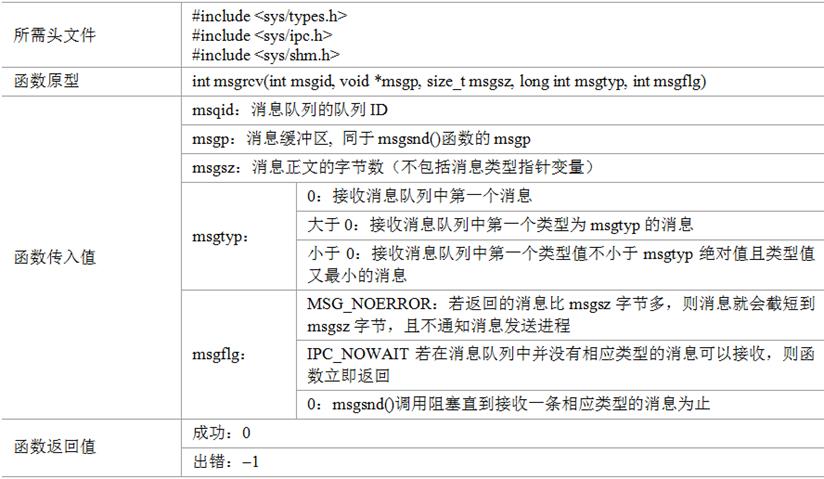进程通信之消息队列
Posted 我有一壶酒
tags:
篇首语:本文由小常识网(cha138.com)小编为大家整理,主要介绍了进程通信之消息队列相关的知识,希望对你有一定的参考价值。
消息队列就是一些消息的列表。用户可以在消息队列中添加消息和读取消息等。消息存在于内核中,有“队列ID”来标识

msgget函数语法:

msgsnd函数语法:

msgrcv函数语法:

msgctl函数语法:

添加消息代码:
/* msgsnd.c 添加消息*/ #include <sys/types.h> #include <sys/ipc.h> #include <sys/msg.h> #include <stdio.h> #include <stdlib.h> #include <unistd.h> #include <string.h> #define BUFFER_SIZE 512 struct message { long msg_type; char msg_text[BUFFER_SIZE]; }; int main() { int qid; key_t key; struct message msg; /*根据不同的路径和关键字产生标准的key*/ if ((key = ftok(".", \'a\')) == -1) { perror("ftok"); exit(1); } /*创建消息队列*/ if ((qid = msgget(key, IPC_CREAT|0666)) == -1) { perror("msgget"); exit(1); } printf("Open queue %d\\n",qid); while(1) { printf("Enter some message to the queue:"); if ((fgets(msg.msg_text, BUFFER_SIZE, stdin)) == NULL) { puts("no message"); exit(1); } msg.msg_type = getpid(); /*添加消息到消息队列*/ if ((msgsnd(qid, &msg, strlen(msg.msg_text), 0)) < 0) { perror("message posted"); exit(1); } if (strncmp(msg.msg_text, "quit", 4) == 0) { break; } } exit(0); }
读取消息的程序代码:
/* msgrcv.c 读取消息*/ #include <sys/types.h> #include <sys/ipc.h> #include <sys/msg.h> #include <stdio.h> #include <stdlib.h> #include <unistd.h> #include <string.h> #define BUFFER_SIZE 512 struct message { long msg_type; char msg_text[BUFFER_SIZE]; }; int main() { int qid; key_t key; struct message msg; /*根据不同的路径和关键字产生标准的key*/ if ((key = ftok(".", \'a\')) == -1) { perror("ftok"); exit(1); } /*创建消息队列*/ if ((qid = msgget(key, IPC_CREAT|0666)) == -1) { perror("msgget"); exit(1); } printf("Open queue %d\\n", qid); do { /*读取消息队列*/ memset(msg.msg_text, 0, BUFFER_SIZE); if (msgrcv(qid, (void*)&msg, BUFFER_SIZE, 0, 0) < 0) { perror("msgrcv"); exit(1); } printf("The message from process %d : %s", msg.msg_type, msg.msg_text); } while(strncmp(msg.msg_text, "quit", 4)); /*从系统内核中移走消息队列 */ if ((msgctl(qid, IPC_RMID, NULL)) < 0) { perror("msgctl"); exit(1); } return 0; }
以上是关于进程通信之消息队列的主要内容,如果未能解决你的问题,请参考以下文章